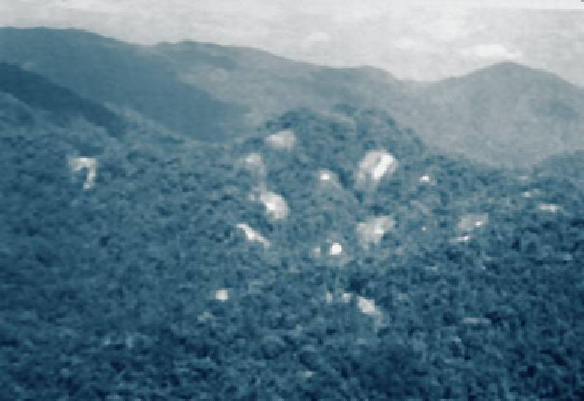Environmental Engineering Reference
In-Depth Information
FIGURE 4.6
Distribution of Drill Sites Accessed by
Helicopter at the Batu Hijau Copper
Deposit in Sumbawa, Indonesia
Recurrent Drilling
As new exploration and mining concepts, methods and targets become known and avail-
able, previously explored areas are often re-explored and re-drilled. Mining geologists in
the 1930s rarely drilled beyond 100 metres in depth. Thus, they only found shallow depos-
its. Today, drill holes beyond 1,000 metres are rare and we only i nd deposits above that
depth. In 50 years time, mining geologists will undoubtedly be probing routinely to depths
of 2,000 or 3,000 metres, i nding deep deposits missed today.
Rigs and their associated down hole equipment are becoming lighter and more efi -
cient. This results in greater opportunity to undertake drilling programmes, with drilling
equipment carried into the i eld manually or by helicopter. The use of lighter machin-
ery for preparing access roads and sites for large skid and wheel-mounted rigs has mini-
mized environmental impacts, allowing a high standard of post-drilling rehabilitation to
be achieved. Chemical additives used to improve drilling performance are biodegradable,
and simple procedures have been developed to prevent drilling l uids from contaminat-
ing adjacent areas. Drill crews and supervisors are industry-trained in all aspects of envi-
ronmental awareness and in the strict regulations designed to minimize environmental
impacts that apply to drilling operations. This ensures that modern exploration drilling is
a low-impact activity, involving temporary effects to very small areas.
Geological survey is thus a systematic investigation of an area determining the distribu-
tion, structure, composition, history, and interrelations of rock units. Its purpose may be
either purely scientii c or economic with special attention to the distribution, reserves, and
potential recovery of mineral resources.
In 50 years time, mining
geologists will undoubtedly be
probing routinely to depths of
2,000 or 3,000 metres, fi nding
deep deposits missed today.
Bulk Sampling
In most exploration work, there is eventually a need for large, representative samples of
the ore deposit (USDA 1995). A i nal cross-check of the grade of the deposit must be made,
as well as testing to determine the best choice of metallurgical method. Bulk sampling may
also yield other valuable data of use in planning mine and haulage facilities, the treatment
method, or disposal of waste. The mining characteristics concern such factors as the way
the rock in an open pit mine may be expected to break during blasting and to support itself
on a bench face, and the manner in which the rock will cave in an underground block











Search WWH ::

Custom Search